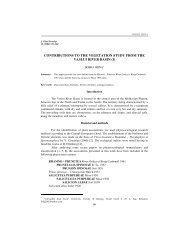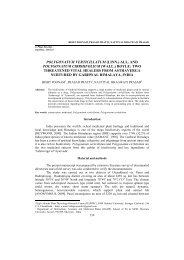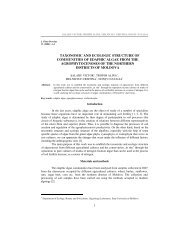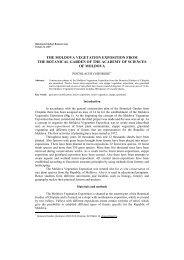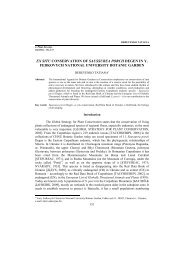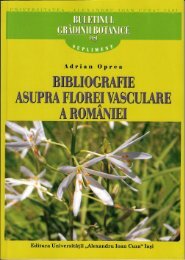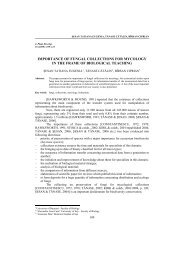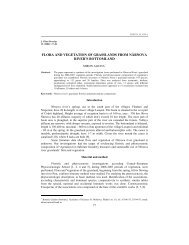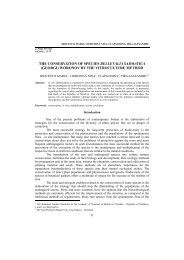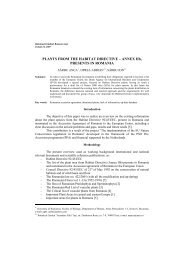buletinul grÄdinii botanice - Journal of Plant Development
buletinul grÄdinii botanice - Journal of Plant Development
buletinul grÄdinii botanice - Journal of Plant Development
Create successful ePaper yourself
Turn your PDF publications into a flip-book with our unique Google optimized e-Paper software.
16<br />
carpocephala hemisphaeric, 2 mm across, 2-4 lobed below; pseudoperianths colorless,<br />
short, with 8 segments which remain connate apically until the spores are nearly mature,<br />
segments narrowly lanceolate, 2,5 mm long, free with age; capsules yellowish-brown,<br />
dehiscing by a operculum; spores yellow, 50 μm in diametre, the surfaces punctategranulose,<br />
the areolae 9-12 μm wide; elaters yellowish, 2-3 spiral medially, 200 μm long.<br />
The species is present in Iceland, Norway, Sweden, Finland, France, Germany,<br />
Poland, Switzerland, Austria, Czech Republik, Slovakia, Spain, Italy, Slovenia, Bosnia-<br />
Herzegovina, Macedonia, Romania, North Russia, East Russia and North Caucasus (9).<br />
In Romania, three species <strong>of</strong> genus Asterella P. Beauv. exist: A. gracilis (F.<br />
Weber) Underw. (syn. Marchantia pilosa F. Weber, Fimbriaria pilosa Taylor), A.<br />
lindenbergiana (Corda ex Nees) Arnell (syn. Fimbriaria lindenbergiana Corda ex Nees)<br />
and A. saccata (Wahlenb.) A. Evans (syn. Fimbriaria fragrans Nees) (1,2,3,9).<br />
Key <strong>of</strong> Asterella species, reported from Romania:<br />
1a. Spores not alveolate, 90-100 μm; ventral scales longly projecting beyond the thallus<br />
margin at the apex; pseudoperianth with segments not free at maturity ....... A. saccata<br />
1b. Spores alveolate; ventral scales not longly projecting beyond the thallus margin at the<br />
apex ................................................................................................................................2<br />
2a. Spores yellow, 50-60 μm; pseudoperianth divided into 6-8 lobes free at maturity ..... A.<br />
gracilis<br />
2b. Spores red-violet, 60-90 μm pseudoperianth divided into 16 lobes not free at maturity...<br />
A. lindenbergiana<br />
References<br />
1. DIHORU G., 2001 – Nume legitime şi sinonime ale taxonilor din Bri<strong>of</strong>lora României (II). Hepatice (A-J).<br />
Acta Horti Bot. Bucurest., 29: 109-128, Bucureşti.<br />
2. MIHAI G., 1983 – Lista hepaticelor din Republica Socialistă România. Analele Şt. Univ. “Al.I. Cuza” Iaşi,<br />
29: 31-34.<br />
3. MIHAI G., PASCAL P. & COSTICĂ M., 1998 – Hepaticele şi muşchii României. O listă a speciilor cu<br />
distribuţia lor pe unităţi teritoriale mai mici (provincii). – The liverworts and mosses <strong>of</strong> Romania. An<br />
annotated list <strong>of</strong> species, with their distribution in the smaller territorial units (provinces). Edit.<br />
Corson, Iaşi, 125 p.<br />
4. MOHAN G., 1998 – Catalogul bri<strong>of</strong>itelor din România. Acta Bot. Horti Bucurest.:1-432.<br />
5. MÜLLER K., 1957 – Die Lebermoose Europas. In Rabenhorst’s Kryptogamen-Flora von Deutschland,<br />
Österreich und der Schweiz. Leipzig, ed. 3, 6(2):784-786.<br />
6. PAPP C., 1967 – Bri<strong>of</strong>itele din Republica Socialistă România (determinator). Analele Şt. Univ. “Al.I.Cuza”<br />
Iaşi, 3: 1-319.<br />
7. RADIAN S., 1915 – Flora bryologică a Romîniei. A III-a contribuţie. Hepaticae cu Thal. Analele Acad. Rom.,<br />
37: 187-198, Bucureşti.<br />
8. RADIAN S., 1923 – Anatomia aparatului vegetativ de la Bucegia romanica Radian. Bul. Şt. Nat., 26(6): 4-77.<br />
9. SÖDERSTRÖM L., URMI E. & VÁŇA J., 2002 – Distribution <strong>of</strong> Hepaticae and Anthocerotae in Europe and<br />
Macaronesia, Lindbergia, 27( 1): 3-47.



